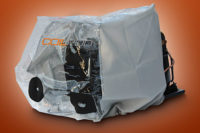The report was issued at the most recent North American Food Equipment Manufacturers (NAFEM) Expo, and followed a report earlier in the year on trends in supermarket refrigeration released at the time of the Food Marketing Institute Show in Chicago.
Technicians
The most recent "Foodservice Trend Report" noted, "The number of people entering the HVACR trade has continued to decrease and the number of fully qualified technicians has also decreased." The impact on the foodservice industry is "longer waiting periods to fix refrigeration products, which increases the risk of food spoilage."Further, technicians may only have time to fix an immediate problem rather than provide preventive maintenance, the report said. On the plus side, the report noted some developments that may help combat the shortage.
It was noted that offsite and on-line monitoring and measuring tools means, in some cases, "technicians can be notified before a piece of equipment stops working, thus ensuring food safety." Further, manufacturers are developing "condensing unit platforms that can be quickly and easily replaced by technicians; changing an entire platform takes less training than diagnosing and replacing individual components."
The report added the industry continues to move toward more "training and development programs designed specifically to quickly teach and reinforce refrigeration principles."
Emerson's update on scrolls said they are "increasingly being used in refrigeration walk-ins. Unlike reciprocating, hermetic, and semi-hermetic compressors which use pistons, scroll compressors use a rotating scroll. The difference results in a more reliable, energy-efficient walk-in, which directly translates into less downtime and food waste."
In the new reality, food security faces threats such as terrorism and sabotage. But the report suggests that traditionally there has not been a link between systems that monitor food quality and security.
But there are changes taking place, the report said. "The result is an integrated food quality program that connects all food quality initiatives and energy and maintenance services technologies to a 24-hour, remote monitoring command center."
The report noted, "There is also a greater awareness of and attention to how all these programs are intertwined and affect each other."
Features of the concept include energy commissioning, energy and equipment monitoring, maintenance performance reports, analysis of historical energy usage, food auditing, bacterial growth-based alarming, wireless temperature sensors, and 24-hour Web-based monitoring of critical temperatures.
The report said that, traditionally, foodservice stores had distributed control systems that required separate modules to manage each system application, and low processing power.
But now: "Technologically advanced controls [can] manage the entire system, including lighting and HVACR from one central location. Enhanced processing power allows a larger quantity of data to be gathered, while on-board Ethernet communications adds the ability to communicate remotely through a variety of configurations."
Publication date: 01/12/2004


